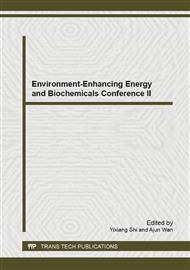[1]
Bulte, E.H., van Soest, D.P., 2001. Environmental degradation in developing countries: households and the (reverse) environmental Kuznets curve. Journal of Development Economics 65, 225–235.
DOI: 10.1016/s0304-3878(01)00135-3
Google Scholar
[2]
Coondoo, D., Dinda, S., 2002. Causality between income and emission: a country group-specific econometric analysis. Ecological Economics 40, 351–367.
DOI: 10.1016/s0921-8009(01)00280-4
Google Scholar
[3]
Copeland, B.R., Taylor, M.S., 2004. Trade, growth and the environment. Journal of Economic Literature 42, 7–71.
Google Scholar
[4]
Dinda, S., 2004. Environmental Kuznets curve hypothesis: a survey. Ecological Economics 49, 431–455.
DOI: 10.1016/j.ecolecon.2004.02.011
Google Scholar
[5]
Dinda, S., Coondoo, D., 2006. Income and emission: a panel-data based cointegration analysis. Ecological Economics 57, 167–181.
DOI: 10.1016/j.ecolecon.2005.03.028
Google Scholar
[6]
Fan, Y., Liu, L.C., Wu, G., Wei, Y.M., 2006. Analyzing impact factors of CO2 emissions using the STIRPAT model . Environmental Impact Assessment Review 26(4): 377-395 (In Chinese).
DOI: 10.1016/j.eiar.2005.11.007
Google Scholar
[7]
Friedl, B., Getzner, M., 2003. Determinates of CO2 emissions in a small open economy . Ecological Economics 159: 133-148.
DOI: 10.1016/s0921-8009(03)00008-9
Google Scholar
[8]
Galeotti, M., 1999. A Study on Carbon Dioxide Emissions in Developing Countries. energy policy 27(10): 565-573.
DOI: 10.1016/s0301-4215(99)00047-6
Google Scholar
[9]
Grossman, G.M., Krueger, A.B., 1993. Environmental impacts of North American free trade agreement. The US-Mexico Free Trade Agreement. MIT Press, Cambridge 13-56.
DOI: 10.3386/w3914
Google Scholar
[10]
Hill, R.J., Magnani, E., 2002. An exploration of the conceptual and empirical basis of the environmental Kuznets curve. Australian Economic Papers 42, 239–254.
DOI: 10.1111/1467-8454.00162
Google Scholar
[11]
Hu, C.Z., Huang, X.J., Zhong, T.Y., Tan, D., 2008. Character of Carbon Emission in China and Its Dynamic Development Analysis . China Population Resources and Environment 18(3): 38-42 (In Chinese).
Google Scholar
[12]
Lantz, V., Feng, Q., 2006. Assessing income, population, and technology impacts on CO2emissions in Canada: where's the EKC? Ecological Economics 57, 229–238.
DOI: 10.1016/j.ecolecon.2005.04.006
Google Scholar
[13]
Perman, R., Stern, D.I., 2003. Evidence from panel unit root and cointegration tests that the environmental Kuznets curve does not exist. The Australian Journal of Agricultural and Resource Economics 47, 325–347.
DOI: 10.1111/1467-8489.00216
Google Scholar
[14]
Ramanathan, R., 2006. A multi-factor efficiency perspective to the relationships among world GDP, energy consumption and carbon dioxide emissions. Technological Forecasting and Social Change 73(5): 483-494.
DOI: 10.1016/j.techfore.2005.06.012
Google Scholar
[15]
Rothman, D.S., de Bruyn, S.M., 1998. Probing into the environmental Kuznets curve hypothesis. Ecological Economics 25, 143–145.
Google Scholar
[16]
Schmalesee, R., Stoker, T.M., Judson, R.A., 1998. World Carbon Dioxide Emissions: 1950-2050 . Review of Economics and Statistics 80(1): 15-27.
DOI: 10.1162/003465398557294
Google Scholar
[17]
Stern, D.I., 2004. The rise and fall of the environmental Kuznets curve. World Development 32, 1419–1439.
DOI: 10.1016/j.worlddev.2004.03.004
Google Scholar
[18]
Stern, D.I., 2000. A multivariate cointegration analysis of the role of energy in the USmacroeconomy. Energy Economics 22, 267–283.
DOI: 10.1016/s0140-9883(99)00028-6
Google Scholar
[19]
Wang, J.S., He, C.F., 2010. Energy consumption, economic growth and CO2 emissions in China—analysis based on logarithm mean divisa decomposure method. Resources and Environment in the Yangtze Basin 19(1): 18-22 (In Chinese).
Google Scholar
[20]
Wang, Z.Y., Wang, L.M., 2006. Economic growth and its effects on carbon emission in China . Journal of Safety and Environment (5): 12-19 (In Chinese).
Google Scholar
[21]
Xu, G.Y., Song, D.Y., 2010. An Empirical Research on the Relationship of Export Trade, Economic Growth and Carbon Emissions. Journal of International Trade (1): 74-79 (In Chinese).
Google Scholar


